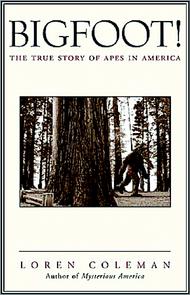For example, his summary of recent findings in primatology and how they can be applied to the hairy question at hand are thought-provoking. But offering as evidence of Bigfoot's existence the fact that many cultures tell Scary Giant stories is a bit sloppy. (He even goes on at some length about the Jolly Green Giant.) And he seems too eager to accept the oddest accounts, like that of a man claiming to have been abducted by Bigfoot for cross-species mating purposes (in the chapter entitled “Sex and the Single Sasquatch”).
If the science is scarce, the lore is abundant, and Coleman happily doesn't skimp. Native American mythology is full of forest-dwelling ape-men. Indian names for the big guy are numerous: Windigo, Chenoo, Skookum, and the cutest of all, Chickly Cudly. There are varied notions of what Bigfoot looks, sounds and smells like. Gugwes, the Micmac version, is said to produce “a sound like a partridge.” (In fact, Coleman writes, Bigfoot emit a high-pitched whistle—alternating with “sooka sooka sooka.”) Some Bigfoot kidnap and eat children, others are gentle vegetarians. All have in common a hair-raising odor.
Modern sightings of the seven- to eight-foot primates with incongruously tiny heads, and the confusion and politicking that surround them, are no less entertaining than the stories of Bigfoot of yore. From the Northwest to Florida, they sniff around campfires and freak out livestock. A whole Bigfoot gang pelts a band of prospectors with stones. Bigfoot have “routinely negative encounters with dogs” and are spotted in a moment of fascination with a car antenna, flicking it with their huge, furry hands. None of these activities, of course, has ever been photographed.
Happenings within the “Bigfoot community” are almost as shadowy. Footprints are bulldozed over, casts are destroyed in house fires; a superb picture of a fiery-eyed giant in someone's back yard (reproduced in the illustrations) arrives in the mail with a note, “Is someone missing an orangutan?,” and no return address. Planes carrying researchers crash, millionaire backers run out of funds, and folks fall out over the kill/no kill debate or the veracity of the Patterson-Gimlin footage or the Skookum Meadow imprint, claimed by some to be an impression of the elusive creature's giant, hairy hiney. (Coleman calls it the “biggest prize” in hard evidence.) Not surprisingly, Coleman's brief profiles of leading Bigfooters, with their tantrums and obsessions, are among his most interesting pages. They're a driven and eccentric bunch.
Bigfoot! is unlikely to convince skeptics with its mix of evidence, anecdote, conjecture and folklore. Still, it's a hard book to resist. Everyone loves a Bigfoot.









